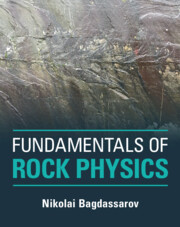Book contents
- Fundamentals of Rock Physics
- Fundamentals of Rock Physics
- Copyright page
- Dedication
- Contents
- Preface
- 1 Introduction
- 2 Density and Porosity
- 3 Stresses in Rocks
- 4 Mechanical Strain and Elastic Moduli
- 5 Permeability of Rocks
- 6 Mechanical Properties of Fluid-Bearing Rocks
- 7 Acoustic Properties of Rocks
- 8 Electric Resistivity
- 9 Dielectric Properties
- 10 Magnetic Properties of Rocks
- 11 Thermal Properties of Rocks and Minerals
- 12 Radioactive Properties of Rocks
- Index
- References
6 - Mechanical Properties of Fluid-Bearing Rocks
Published online by Cambridge University Press: 19 November 2021
- Fundamentals of Rock Physics
- Fundamentals of Rock Physics
- Copyright page
- Dedication
- Contents
- Preface
- 1 Introduction
- 2 Density and Porosity
- 3 Stresses in Rocks
- 4 Mechanical Strain and Elastic Moduli
- 5 Permeability of Rocks
- 6 Mechanical Properties of Fluid-Bearing Rocks
- 7 Acoustic Properties of Rocks
- 8 Electric Resistivity
- 9 Dielectric Properties
- 10 Magnetic Properties of Rocks
- 11 Thermal Properties of Rocks and Minerals
- 12 Radioactive Properties of Rocks
- Index
- References
Summary
Poroelastic problems are considered for drained and undrained rock conditions. The effective pressure coefficient a for bulk modulus is introduced to describe the effective pressure. The Skempton’s coefficient characterizes the relationship between pore pressure change and change in ambient pressure. The Gassman equation relates the bulk modulus of rock matrix, fluid and undrained rock with porosity and drained bulk modulus. Pore pressure follows the diffusion type equation: fluid transport and diffusion. Stress in rocks at depth may be estimated from hydraulic fracturing conditions. To calculate effective bulk and shear moduli of porous rocks, the differential Mori-Tanaka scheme is used. The effective bulk and shear moduli of a medium containing a family of identical-shaped pores can be expressed via the pore compressibility P and shear Q compliances. Focus Box 6.1: Elliptical coordinates and elliptical-shaped pores.
Keywords
- Type
- Chapter
- Information
- Fundamentals of Rock Physics , pp. 211 - 244Publisher: Cambridge University PressPrint publication year: 2021

